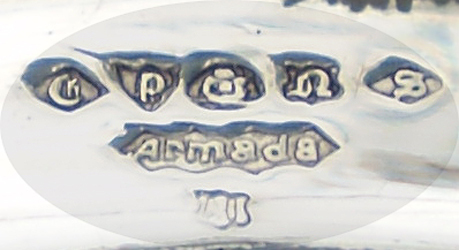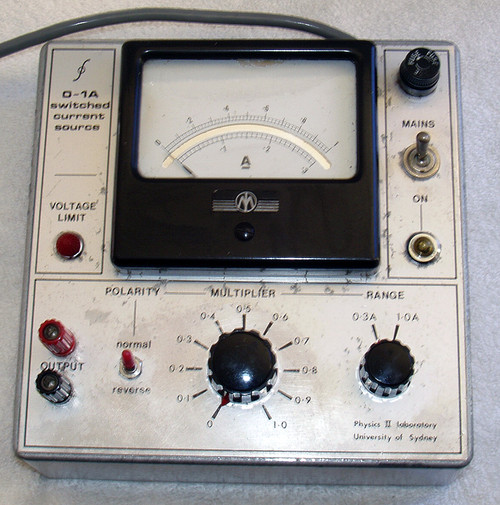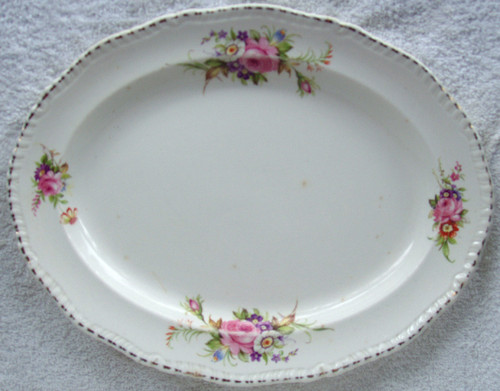HISTORY (OR WHAT I HAVE OBSERVED ABOUT THIS DISH)
First up, it is important to get something right out of the way ... although this dish is stamped Armada, it has not the remotest connection with the infamous Silverware from the Tudor period, often referred to as the Armada collection, most of which is now held in the British Museum.
This dish is relatively 'modern' in production with a pretty straightforward design and not much in the way of 'frills' i.e decorative work. To us it looks very 1960's ~ 1970's period but a couple of aspects caught my intense attention.
The weight, compared to other silver plate dishes of this type that we have had or been asked to offer to others, is strangely distributed. The top section of the dish is slightly HEAVIER than the base. Most other dishes that I have been handling lately have a top section which is lighter (sometimes much lighter) than the base section.
The dual handles, these are a bit of a mystery to us. The handle sits between two brackets and is held in place by two fancy threaded bolts, both of which are ENTIRELY Silver plated and quite heavy (3g each bolt)
The handle itself appears to be made from an organic material, it is definitely NOT plastic and neither is it bakelite. Each handle is 38.2mm length x 15.5mm diameter and has a central threaded 3.6mm diameter hole completely through the material. This handle weighs 9g. While it is externally coloured Black, in fact I can see it is a Brownish colour underneath (a small part of the handle has the actual material surface showing). My wife immediately pointed to wood as being the material but I tend to lean towards animal bone. On the surface of the material and also visible 'end on' are numerious very fine cracks running in all directions, this looks quite similar to sun-baked mud which has subsequently cracked if you can imagine that. It just doesn't look like wood (no signs of grain or splintering etc) and when the two pieces are knocked together they sound just like two pieces of an organic material hitting each other, not wood, which sounds duller.
The design of the dish is "no nonsense" in that it features straight lines with very little decoration, in fact the only decoration is on the lid section, two lines which look something like a braid.
The maker's stamped mark is on the underside at one end of the dish and here is a closeup of that mark

After many, many hours of research on the excellent Silver Plate makers marks website reference HERE, I could not establish with certainty who made this dish. The EP and NS are pretty clear but that Gothic style 3rd stamp is a mystery to me.
Armada is pretty clear to read but I could not find any references to a Silversmith which used Armada as their tradename or trademark.
The last two stamped impressions (3rd row) are difficult to view in the above photograph but clearly say A 1 - confirming it is indeed Silver Plate, although of a high grade (thickness)
I am assuming this is Nickel based although it 'could' be Copper based (it is quite 'weighty') but this is not indicated in the makers mark.
Overall I get the distinct feeling of "quality", the workmanship is to a high standard, the finishing is nice and clean, even the handle bolts are Silver plated, the Silver plate has no obvious 'Greenish' oxidisation spots anywhere and the use of what appears to be bone is intriguing (to me at least, my wife always thought it was wood but it just doesn't look or feel like wood).
Yes, the dish has been given a cleanup, I wanted to be sure that there were not other stamped marks on the dish which could help me identify the maker, and i noticed that the surface was so easy to clean and even where there has been a few scratches (on top of the lid in particular), there is no 'plateware base metal break through' - all you see is the Silver.
Although this dish is pretty 'young' by English Silversmith and Electroplaters standards, it is estimated to be around 50+ years old and after all this time it remains in pretty good condition.
Phew! after that long and wordy introduction, let's get down to some details ...
SILVER PLATED LIDDED TABLE DISH
Maker is not confirmed - unable to identify the stamp marking
Presumed (but not confirmed) to be made in England, likely the Sheffield area due to the myriad of Silversmiths operating in this area over the years but of course there were other 'clusters' of Silversmiths, such as Glasgow.
At first we did wonder if this dish was Sterling but the makers stamped mark A1 is the giveaway, this is definitely Silver plated but the base metal is not known - for it's size this is quite a heavy dish. Because the Silver plating is largely unworn, there are no clues from areas of wear showing the base metal underneath ...
Two part dish design i.e base with lift off lid
Two handles, one at each end of the top section, not a single central 'knob' which is commonly used for this type of dish.
It appears as though the handles are made from an animal organic material, probably bone.
Minimalist decoration has been applied to the dish, in fact simply two "braids" running across the top of the lid section, no other decoration at all.
DIMENSIONS:
Oval shape 259mm length x 215mm wide x 60mm height
Weight: 960g
The base is flat and without footings, for this reason we only used this dish for cold cuts - it would not be a good thing to have hot food in this dish, sitting on our gorgeous Mahogany table top!
COSMETIC CONDITION:
USED
CLEAN
Very high lustre (Oh you bright shiny thing, you!)
Yes, there are some very light ~ light scratches in the surface but none are what we would consider visually objectionable.
There are also a couple of very light, small 'dots' on the inside top section and inside base but again, none of these ever worried us at all - NONE of these marks look "Greenish" which is due to oxidisation and partial breakdown of the plating, showing the base metal underneath.
There are NO dents or damage caused through normal handling, we have always been very careful with this dish and it has not been "knocked around"
To preserve the current very good condition, I have placed the dish within a completely sealed clear plastic packaging (airtight) in the hope of reducing any tarnishing to the metalwork. Some people (purists) seem to like their Silver/Silverplate with patina, we don't! We ate out of this dish and there was no way we were going to put a dish with heavy patina on the dining table ... guests would be horrified!




















